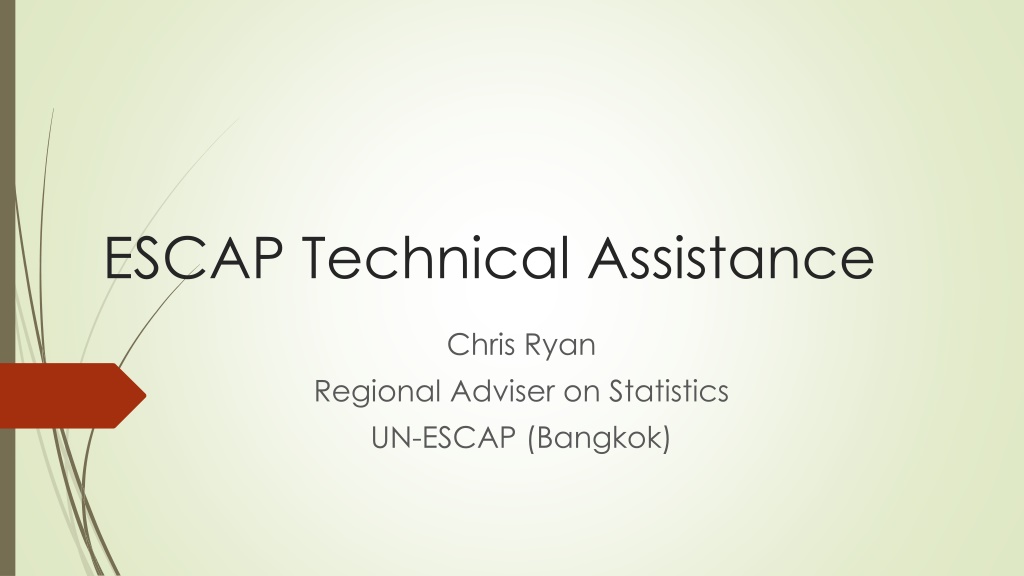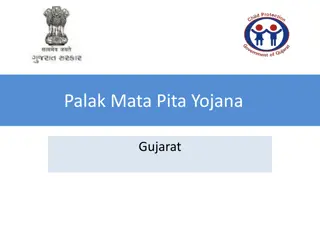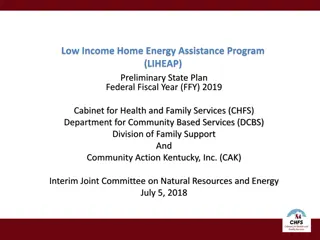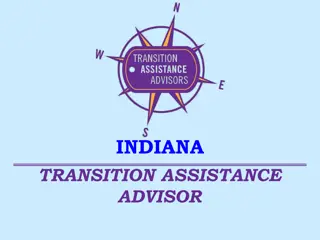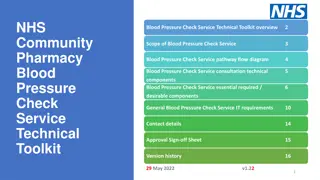ESCAP Technical Assistance
ESCAP provides technical assistance for the development and implementation of regional indicator frameworks in Asia-Pacific. This includes support for economic, population, social statistics, CRVS, disability, and disaster statistics. Workshops and consultations aim to enhance data collection and analysis, facilitate policy review, and improve communication between data users and producers. The focus is on accelerating the implementation of frameworks to meet regional statistical needs effectively.
Download Presentation

Please find below an Image/Link to download the presentation.
The content on the website is provided AS IS for your information and personal use only. It may not be sold, licensed, or shared on other websites without obtaining consent from the author. Download presentation by click this link. If you encounter any issues during the download, it is possible that the publisher has removed the file from their server.
E N D
Presentation Transcript
ESCAP Technical Assistance Chris Ryan Regional Adviser on Statistics UN-ESCAP (Bangkok)
Structure of presentation 1. Support to Regional Indicator Frameworks 2. Activities and experiences with SDG implementation
Support to Regional Indicator Frameworks Economic Statistics Established ESCAP Resource Facility Pool of funds support NSSs to undertake analysis and research to develop economic statistics Scope of research must cover Core Set of Economic Statistics EG: Development of Business Register, to serve as a frame for future economic surveys Population & Social Statistics (including Gender) Developed and delivered workshops on disaggregated data for the SDG indicators in Asia and the Pacific (focus on gender disaggregation) Workshops have brought about recommendations for the region Countries need to review policy to identify key target groups Better communication between users and producers to establish disaggregation requirements Better utilization of existing data sources
Support to Regional Indicator Frameworks CRVS Host Regional Steering Group for CRVS in Asia-Pacific Meetings. Monitor progress of the Asia-Pacific Regional Action Framework (RAF) Identify challenges to meeting the vision of the RAF Propose recommendations to accelerate implementation of the RAF Monitor progress in production of baseline indicator reports Disability statistics Incheon Strategy Undertaking national consultations to build member States capacity for collecting reliable and comparable disability data 14 National Studies done Only Marshall Islands covered in the Pacific so far Disaster statistics Sendai Framework Carrying out pilot studies in 4 countries (including Fiji), to identify problem areas with collecting disaster statistics aim to develop a framework for collecting disaster statistic
Activities and Experiences with SDG implementation ESCAP has recently embarked on a series of sub-regional workshops entitled Data and Statistics for Sustainable Development Goals Two workshop conducted thus far South Asia (6 countries) North and Central Asia (8 countries) A key objectives of the workshop: Provide participants with a clear understanding of the emerging SDG indicator architecture, data availability and links and implications to existing indicator-based monitoring frameworks and build national statistical capacity to provide relevant data to monitor development progress That is, to assist countries with implementing SDGs in to National Development Plans (NDPs)
Assist countries with implementing SDGs in to National Development Plans (NDPs) Start of the workshop we asked countries to present: Details of their National Development Plans Status of National SDG Implementation In response to these requests we noticed two very significant things: Countries National Development plans were very different Approaches to implementing SDGs was not the same for any two countries
Sub-regional Workshops (cont) Some of the activities happening at the moment: Creation of National SDG Coordination Mechanisms Established an SDG Coordination Committee Developed thematic working groups to tackle SDGs Assigned Ministries responsibility over SDG goals Mapping type activities SDG goals to thematic areas of NDPs Rapid Integrated Assessment (UNDP) Undertake SDG indicator Gap Analysis Commenced work on incorporating SDGs in to NDPs MAPS: Mainstreaming, Acceleration and Policy Support (UNDG) Development of SDG Road Map Conducted SDG Localization Workshops Commenced integrating SDGs in to National Plans Other Baseline work commenced
Sub-regional Workshops (cont) Why is this happening? No clear step-by-step process developed on how countries should implement SDGs at the National level, thus no common approach being adopted Don t expect countries to implement SDGs exactly the same BUT The approaches shouldn t differ too much
Relevance of the SDG lesson? The process of how countries proceed with adopting and implementing the Pacific Island Indicator list is similar to the process of how countries should proceed with adopting the global SDG Indicators One is adopting a regional set One is adopting a global set What is the strategy proposed by this workshop on how to implement the core statistics/indicators for the pacific at the national level?
What will be the next step? A couple of options 1. Undertake an Indicator Gap Analysis for each Pacific Island Country a) What s missing? b) How can we fill these gaps? c) Start producing regional reports based on the core set 2. Present the final list to countries in the region to see how best it can be utilized to develop a national indicator framework for inclusion in their national development plan a) Countries choose from the list what is relevant to them b) Countries modify indicators as appropriate c) Countries add to the list with additional national priority indicators A couple of questions Q) How heavily will countries be encouraged to adopt the pacific indicator list? Q) What guidance will countries be given on how they can modify the list to better accommodate their national priorities?
